Tax Refund in Chengdu
Attraction Overview
As one of China’s oldest and best-preserved imperial gardens, Beihai Park has witnessed 870 years of history since its founding in 1153 during the Jin Dynasty. Spanning 68 hectares (equivalent to 95 football fields), this landscape masterpiece served as the core imperial retreat for the Yuan, Ming, and Qing dynasties. Its pioneering "One Pond, Three Islands" design—symbolizing Penglai’s mythical mountains within the Taiye "Sea"—established the blueprint for classical Chinese gardens, directly influencing landmarks from Chengde Mountain Resort to the Chinese Pavilion at Versailles. Recognized as a UNESCO World Heritage site in 1987 under "Imperial Gardens of Beijing," it was hailed by Oxford art historian Michael Sullivan in The Arts of China as "a living fossil crystallizing the East’s most profound philosophy of time and space."
Historical & Cultural Stories
Myths & Legends
-
The Ancient "One Pond, Three Islands" Vision: Beihai's core design embodies the ancient Chinese myth of paradise. Qionghua Islet symbolizes Penglai, the immortal mountain, rising from the "Taiye" pond – an emperor's realized dream.
-
The White Dagoba: Built by Emperor Shunzhi, this Tibetan Buddhist stupa dominates the park. Its white form and golden spire symbolize imperial-Tibetan ties and remain Beihai's spiritual heart.
-
Emperor Qianlong's Legacy: Qianlong frequented Beihai, documenting Qionghua Islet's history and beauty in his "Record of the White Dagoba Hill". His words, carved on steles within the park, highlight Beihai's enduring significance.
Echoes in Art & Literature
-
Literary Landscapes: Literary giants like Zhu Ziqing captured Beihai's lakescapes and vibrant civic life (like the Lotus Market) in works like "A Trip to Beihai Park". Lao She vividly portrayed its winter scenery and the resilient spirit of Beijingers who made it their stage.
-
A Nation's Soundtrack: The melody of the 1955 children's song "Let Us Row Our Oars", featuring lyrics about the "beautiful white pagoda reflected on the lake", is forever linked to Beihai, becoming cherished cultural memory.
-
Silver Screen Sentiments: The carefree childhood scene of Cheng Dieyi and Duan Xiaolou splashing in the water from the classic Farewell My Concubine was filmed here. The snowy walk shared by Wen Jiajia and Frank in Finding Mr. Right also unfolded within the park, capturing a quiet romance. Beihai's lake, pagoda, and benches have silently witnessed countless moments of cinematic joy, sorrow, and love.
Must-See Spots
-
Qionghua Islet(琼华岛)
Being the central island of the park, it features mythical Kunlun Mountain-inspired rockeries, crowned by the White Dagoba with Tibetan Buddhist temples below, reflecting an emperor’s quest for eternity.

-
White Dagoba(白塔)- On Qionghua Islet
A 35.9m Tibetan stupa with white base, gilded spire, and bronze canopy - Beijing’s ancient skyline marker. It is built by Emperor Shunzhi to honor a Tibetan Lama, fusing imperial authority with esoteric Buddhism.
-
Little Western Heaven (小西天)
It's a hybrid Han-Tibetan Buddhist hall built by Qianlong for his mother’s birthday, featuring a square pavilion surrounding a pool with Guanyin statue.It symbolises the Blend of Chinese Pure Land beliefs and Tibetan mandala design, showcasing Qing imperial religious syncretism.
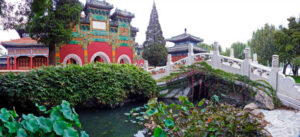
-
Nine-Dragon Glazed Wall(九龙壁)
It’s one of China’s three surviving Nine-Dragon Walls: 27m double-sided porcelain mosaic with 424 dragon motifs. Dragons = imperial power; Nine = supreme authority; porcelain brilliance proclaims royal majesty.
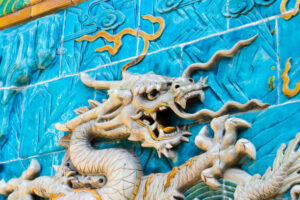
-
Five-Dragon Pavilions (五龙亭)
It’s an imperial viewing deck, with five interconnected lakeside pavilions with upswept roofs mimicking dragon heads – reflections create "dragon playing with pearl".
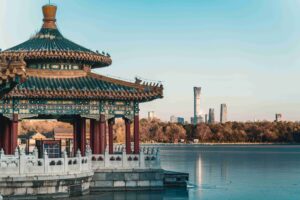
Cultural Immersion
Hanfu Photography Experience:
Dress in Ming/Qing-style Hanfu for photoshoots with White Dagoba and marble boats as backdrops. Includes traditional makeup (kingfisher-feather hairpins + floral forehead designs) + 1-hour professional photography.
-
Studio: Shijinyuan Hanfu Studio
-
Location: East of Qiongdao Chunyin Stele (near South Gate)
-
Pricing:
Basic: ¥198 (1.5hr costume rental + self-service)
Premium: ¥598 (makeup + pro photographer + 9 retouched photos)
-
Tips: ⏱️ Best light: 1hr after opening / 2hrs before closing 🌸 Magnolia blossoms (spring) & ginkgo leaves (autumn) make perfect natural sets
Imperial Craft Workshops:
-
Workshop: Royal Artisan Hub
-
Coin Rubbing: Create prints of mythical beasts from Yuan Dynasty Iron Shadow Wall(¥88 , includes framed scroll)
-
Enamel Painting: Decorate White Dagoba-shaped porcelain plates (¥168 , firing & shipping available)
-
-
Location: Kuai Xue Tang Cultural Zone (North Shore)
-
Highlight: Daily demo by heritage craftsmen at 14:00
Kunqu Opera Tea House
Sip jasmine tea while watching Peony Pavilion excerpts (Wed/Sat 15:00) in imperial tea house. Teahouse: Fangshan Tea Opera
-
Location: Yi Lan Tang historic complex
-
Pricing:
Standard: ¥128 (with traditional desserts)
VIP: ¥198 (uses Forbidden City-style tea set)
Cultural Souvenirs
1.Dagoba Aroma DiffuserDescription: Glass replica of White Dagoba with pine fragrance, removable spire for refills
Shop: Beihai Gifts
Location: Near Qionghua Island cable car station
Price: ¥128
2.Imperial Gardens Silk Scarf
Description: 100% silk printed with Qing Dynasty "One Pond Three Islands" map
Shop: Yuanbo Cultural
Location: Hao Pu Jian scenic area (East Bank)
Price: ¥298
3."Let Us Row Oars" Music Box
Description: Hand-cranked brass music box with boat-shaped base playing the classic tune
Shop: Memory Melody
Location: Five-Dragon Pavilion gift shop
Price: ¥75
FAQs
Hours:
-
Peak (Apr-Oct): 6:30-21:00 (Last entry 20:30)
-
Off-Peak: 6:30-20:00 (Last entry 19:30)
Tickets:
-
Apr-Oct: ¥20 (Combo)/¥10 (Entry)
-
Nov-Mar: ¥15/¥5
Booking:
-
Official WeChat/ <http://www.beihaipark.com.cn>
Official Website/<https://www.beihaipark.com.cn/>
-
3 days ahead for July-Aug
Guides:
-
English Audio Guide: ¥40 (Deposit ¥200)
-
Licensed Tour: ¥300/group (2hrs)
Rules:
-
No swimming/drones.
-
East Gate has wheelchair ramps.
Nearby Options
Local Bites
-
Imperial Roast Duck (京味烤鸭)
-
Flavor & Ingredients:
Crispy mahogany skin wrapped with tender duck meat, scallion, cucumber, and sweet bean sauce in thin pancakes. Signature "crispness-under-bite" texture perfected over wood-fired ovens.
-
Restaurant: Liqun Roast Duck (利群烤鸭店)
Distance: 900m (12-min walk from North Gate)
How to get there: Exit Beihai North Gate → Walk east along Di’anmen Outer Street → Turn into Beixiangfeng Hutong (look for smoke from traditional oven!)

-
Palace-Sweetened Pastries (宫廷甜点)
-
Flavor & Ingredients:
Rose-scented "Douding" (豌豆黄, chilled pea cake) & jujube-filled "Ai Wo Wo" (艾窝窝, sticky rice balls) – lightly sweetened with honey, showcasing Qing Dynasty dessert aesthetics.
-
Restaurant:Huguo Temple Snacks (护国寺小吃 ) @ Huguosi Street
Distance: 1.2km (8-min bus ride or 15-min walk)
How to get there: Take Bus 111 from "Beihai North Gate (Beihai Beimen) stop → Alight at "Huguo Temple (Huguosi)" (2 stops). Or stroll through Shichahai’s lakeside path.
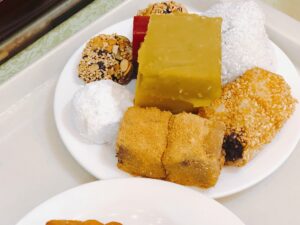
-
Fermented Bean Juice Challenge (豆汁儿)
-
Flavor & Ingredients:
Tangy/sour fermented mung bean broth served warm with pickled mustard greens (Jiecai) and crispy fried dough rings (Jiaoquan). An acquired taste beloved by locals.
-
Restaurant: Baodu Feng (爆肚冯) @ Houhai
Distance: 1.5km (20-min scenic lakeside walk)
How to get there: Exit Beihai North Gate → Walk north along Qianhai Lake → Pass Silver Ingot Bridge → Find blue sign at Yandai Xiejie.

surrounding scenic spots
1. Jingshan Park (景山公园)
Ming Dynasty’s feng shui guardian hill with capital’s most commanding panorama.
📍 Distance 500m (10-minute walk north via Beihai North Gate).
⏰ Visit Time: 1–1.5 hours.
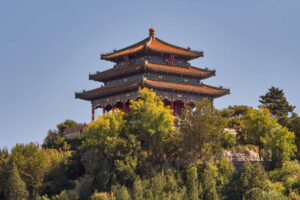
2. The Forbidden City (故宫博物院)
The world’s largest palace complex with cultural exhibitions.
📍 Distance: 1 km (15-minute walk southeast from Beihai’s south gate).
⏰ Suggested Visit Time: Half to full day.

3. Shichahai Lakes (什刹海)
Timeless waterside tapestry
📍 Distance: 800m (15-minute walk east from Beihai’s north gate).
⏰ Suggested Visit Time: 2–3 hours (best at dusk).
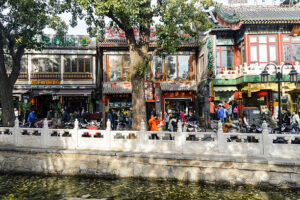
Efficient Itinerary Idea
Morning: Forbidden City → Lunch (try imperial cuisine at Jingshan Park’s corner restaurants) → Afternoon: Beihai Park → Evening: Shichahai sunset + dinner by the lakes.
All sites are walkable or a short rickshaw ride away. Each offers a unique slice of Beijing’s imperial past and local charm!
Let Beihai's breeze dance you through centuries of stories!
